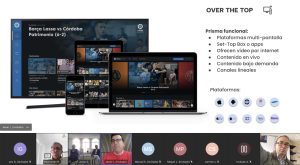
THE MEDIA CAN CREATE A 'NETFLIX OF NEWS'.
Streaming movies, as well as series, concerts and sporting events are now part of everyday life. Why not broadcast the news in this way?
This alternative for the media was discussed in the webinar organized by EditoRed on Wednesday, November 15, 2023.
Javier Oliver Moll, CEO of Tyris Software S.L., a company specialized in the creation and management of video platforms, participated in the event.
These systems are known as OTT, which stands for Over The Top. In general, these are websites and applications that allow users to watch, whenever and wherever they want, videos or live broadcasts. They are capable of displaying this content on any type of screen: computer, mobile, TV, tablet. And they can work with the different operating systems on the market.
The system delivers a large amount of statistical information so that whoever manages the platform can better know its audience, the impact of its content and thus can guide its editorial and commercial strategies.
THE ERA OF VIDEO
Just as we have lived through the computer era since the 1990s and the Internet era since 2000, we have been living through the video era for the last three years. Oliver Moll says. “We have to start now in the video race, we have only lost three years,” says the expert. He asks to keep in mind that this is not a passing thing. “We are talking about an era: the era of video, data, user engagement (loyalty), Smart TV connected to streaming. If we are not on that bandwagon we are going to have problems,” he predicts.
An era that has some dominant companies, but in which smaller initiatives are opening up more and more space. According to U.S. statistics from Comscore CTV Intelligence, in that country, Netflix took 26% of video viewing hours in May 2022; YouTube, 24%; Hulu, 14%; Amazon Video, 10%. The remaining 26% was shared by multiple platforms that have smaller numbers of users (such as Disney+, HBO Max, Pluto TV, Spectrum TV…). One year later, in May 2023, this multi-platform segment grew to 33% of the total, and new players, such as ESPN and PeacockTV, have already been included.
And the number of hours of video viewing among all these platforms is on the rise. It went from 9.6 billion hours in May 2022 to 11.5 billion in May 2023.
So, says Oliver Moll, there is room for the media to create their own OTT.
MONETIZATION
There is no one way to monetize the content proposed to an OTT audience. There are at least four.
Deciding which option to choose depends on the situation of each media outlet, the amount of audience it already has, and the type of audience it is targeting. A medium dedicated to political issues will not be the same as one dedicated to sports or travel.
One of the options is subscription. That is, the monthly or annual charge to the person who wants to watch the content of this platform. As Netflix does. This way of monetizing allows to have a clear income forecast. However, it requires a larger amount of videos available to the user.
This path, explains Oliver Moll, is more advisable for large media, which have a large audience, especially composed of professional people, with fixed incomes.
But if it is a medium with a still small audience, the option is to give the content for free and finance itself with ads. This advertising can be managed autonomously and also through systems that distribute ads to platforms based on the number of views, as is the case with YouTube. It should be taken into account that, if the audience is too low, it is not a profitable alternative because there will not be enough sponsorship to sustain the operation.
Another way is the so-called transactional or Pay Per View. In this, the platform gives most of its content for free, but charges to watch special events of high interest. For example, a soccer match, a concert, an artistic event… The advantage is that it can be combined with the ad model, but it requires guaranteeing a recurring offer of high-interest events.
The fourth option is known as FAST, which stands for Free Ad-Supported Video Television. They are a version adapted to the digital environment of traditional TV channels. They have a programming grid, with the advantage that the user can fast forward or delay the program he is watching. It is financed through ads, but the difference is also that the programming can be customized for the type of user. If a person, for example, likes politics, tennis and agriculture, a channel can be configured with content that addresses those tastes.
THE MAGIC NUMBER
Is there a minimum number of users required to support a streaming video channel, either for subscription or ad-based models? Oliver Moll does give a figure: two thousand monthly active users.
Of course, each case and circumstance should be analyzed, but for less than two thousand active users, it would be difficult for an advertiser to be willing to pay for ads. It should be considered that, for example, in Spain, for every thousand views the advertiser pays four euros.
“From a critical mass of 2,000 active users per month, there is already a good prospect of financing,” either through advertisements or subscriptions, says Oliver Moll.
This text is free to use. If you plan to use it, please cite EditoRed.



